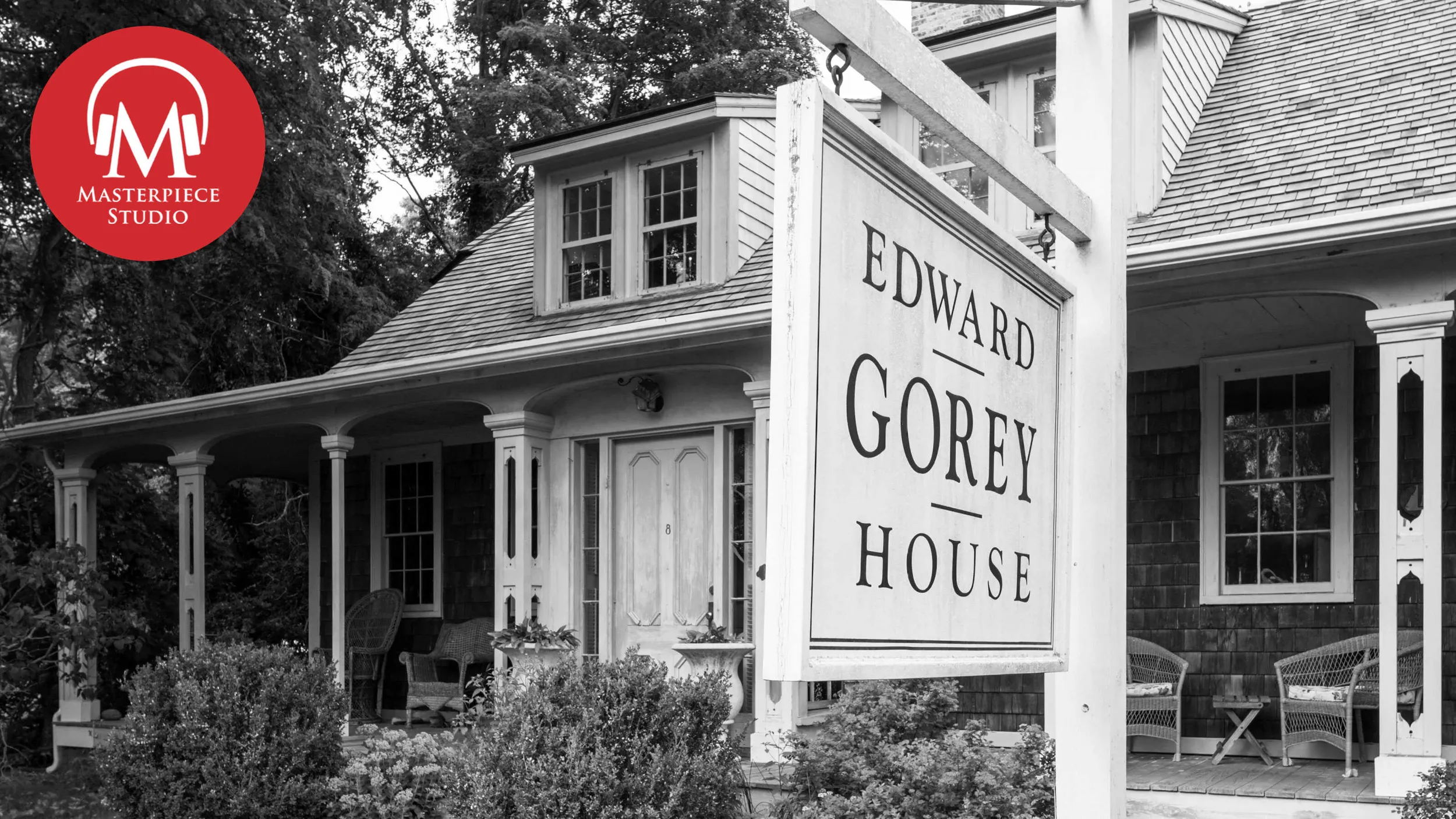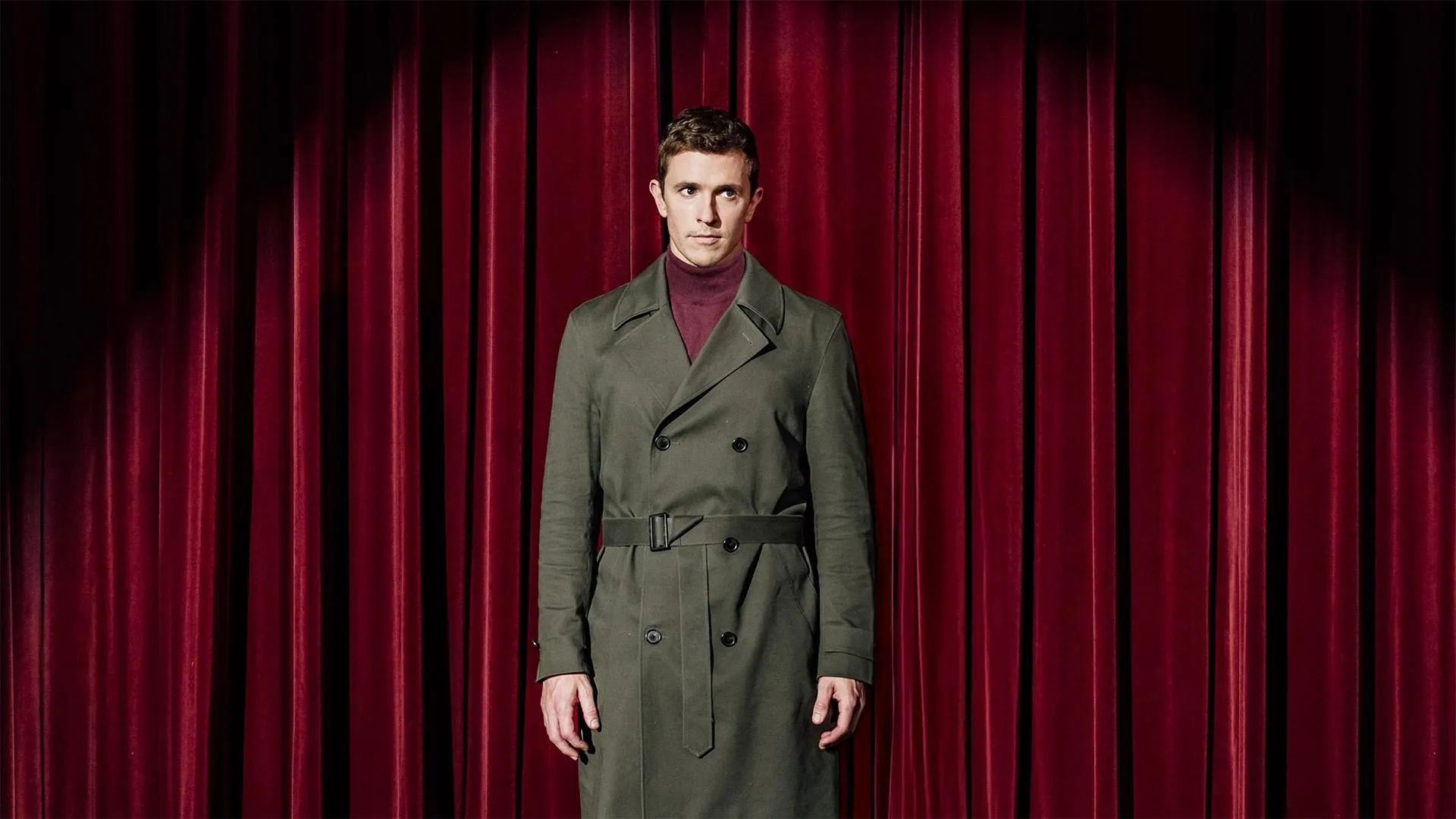
Edward Gorey's Spooky Art Isn't Such A Mystery After All
Released October 31, 2018 12:48
For almost 40 years, the MASTERPIECE Mystery! title sequence has offered viewers an ominous glimpse into the dark unknown. It's a vision made real by the masterful work of illustrator and author Edward Gorey, and his fictional affiliation with the criminal world continues in a special mystery-themed exhibit at the Edward Gorey House in Yarmouth Port, MA. In a special bonus Halloween episode of MASTERPIECE Studio, producer Nick Andersen visits the Edward Gorey House to learn more about the man behind Mystery!'s uncommonly deadly masonry. Edward Gorey House curator Gregory Hischak offers his insight.See our behind-the-scenes slideshow featuring images from our visit to the House.
For almost 40 years, the opening sequence of MASTERPIECE Mystery! has been, well...deadly.
In what has become a truly iconic animated sequence, corpses litter a Victorian landscape as dancers waltz, detectives search for clues, and a hefty chunk of ornate masonry falls with a bone-crunching thud.
The sequence is based on the work of legendary illustrator, author, and designer Edward Gorey. But who was Gorey, and how did his spindly Victorian-style illustrations first appear on PBS screens back in 1980? Producer Nick Andersen visited the Edward Gorey House in Yarmouth, Massachusetts to learn more.
Nick Andersen: If you’re like me, your first — and perhaps only — exposure to the work of Edward Gorey was in the opening title sequence to MASTERPIECE’s Mystery! series on your local PBS station. It’s a magisterial exploration of the unknown. Lightning strikes, skulls wink and an Edwardian-era British house party is nearly upended by a mysterious cloaked figure, lingering rainstorms and wayward pieces of masonry. The title sequence was a real highlight of my early childhood, and my father and I came to eagerly anticipate Thursday evenings on Detroit Public Television as our own private passport to the quaint world of British crime.
Gregory: There was a whole group of people who knew Edward just from PBS Mystery! credits. That's what he's famous for to a certain age group of people, you know, there are people who know him just from the Anchor / Doubleday books. There are people who know him from the covers of all of the John Bellairs young adult mysteries. He did about 20 of those. So he's a very funny, kind of elephant where all these blind people kind of tap the side of him and come up with different interpretations of what Edward is.
Gregory: I'm Gregory Hischak, I'm the curator here at the Edward Gorey House and this is the house that Edward lived in.
Nick: The Edward Gorey House — a charming shingled cottage full of spindly drawings, dusty books and, yes, cheese graters — is a wonderful collection of all of the contradictions that make Edward Gorey so totally endearing.Gorey was born in Chicago in 1925, attended Harvard University and spent much of his early professional life as an illustrator and author living in New York City. He drew covers and in-text illustrations for the Doubleday publishing house, and eventually came to write and illustrate his own works as well.
Gregory: He'd stay late at work, and started working on these small inexplicable little books of his own which are all kind of our predecessors to what we would call a graphic novel. Now they were they were indescribable little graphic books, with small amounts of text, sometimes in rhyming verse, that Edward would hand draw. They all were macabre and kind of Edwardian, kind of First World War. They were all extremely deadly and all extremely funny. The first one was The Unstrung Harp, in 1953 and then he found another publisher to publish The Listening Attic. Then he got another publisher to publish, you know, The Object Lesson. And then another one to publish The Doubtful Guest and he was putting out about a book, sometimes two a year, almost always with different publishers. He ended up, by the time he died, he had put out 116 books. Some of them are inexplicable tiny books that you can't even open, some of them are huge, you know, and some of them didn't have any text, some of them were nothing but text. They're all over the place. But it was a huge body of work that he put out. And that's really what he's famous for.
Nick: While living in New York, Gorey attended every performance of the New York City Ballet, and became known for his constant presence in the theatre, as well as for his fur coats. But the death of famed New York City Ballet artistic director George Ballachine spurred a major change in Gorey’s life.
Gregory: Balanchine died in 85 or 86, and Edward suddenly realized that he had no reason to live in New York anymore, and so he finally moved to the Cape full time and moved into this house. He bought this house in 1979 with a big royalty check from the production of Dracula in New York. And. He spent some time fixing it up. It was a shambles and he put in all the cabinetry that you see. He fixed up the wall….it was a wonderful, wonderful old sea captain's house. 1825, it was originally built, and then added to, the way all Cape houses are. This used to be a room before it became a bigger room, you can see on the floor where previous rooms where. Edward looked through that window over there in 1979 and liked the house. He thought it was interesting and had potential. He wrote a check for the house without coming inside of it, and eventually he came inside of it and it was a little bit of buyer's remorse situation that happened, I think, as they discovered there was no heat in the house at all except a couple of fireplaces because it had been a summer house and there was no contemporary plumbing or the plumbing...It was called The Elephant House because of the pictures, because of the texture, because of the white elephant nature of the house and the fact that it was a huge house for Edward.
Nick: Long before his move out to the Cape, Gorey had made a real name for himself on the Broadway stage with the 1977 production of playwright John Balderston’s version of Bram Stoker’s horror novel, Dracula. The play was a smash success, and lead to a Tony Award for Best Costume Design for Gorey (who forever resented that his epic set design was not similarly awarded) and eventually lead the producers of PBS’s British drama anthology series, MASTERPIECE to arrange to have British animator Derek Lamb collaborate with Gorey to create the title sequence of their upcoming crime-related spinoff series, Mystery!. Today, the haunting strains of the waltz wax gently behind the red MASTERPIECE book, and the Gorey figures come to life via the volume’s flipping pages.
Gregory: It was a cool little project and the the residual work that came from it every year. WGBH asked Edward to design the press kits, promotional stuff, newspaper things, magazine things, so quite busy seasonally. WGBH became quite a big client of Edward’s. They paid for a lot of books that came into the house, and they paid for a lot of cat food.
Jace: Before this next question, a quick word from our sponsors…
Viking. Viking’s all new, custom-built ocean fleet is designed to bring the traveler closer to the destination, with all veranda staterooms and a shore excursion included in every port. Viking. By River and by Sea. Learn more at VikingCruises.com
Nick: Gorey was a man who did exactly what he wanted, when he wanted, and he didn’t quite care if you came along with him.
Gregory: He started drawing at 18 months. We had this first drawing over there. His mom saved everything. Eighteen months. It's really quite good. He was drawing this from his first book. It was called Supplement With Cats, and it has already, he was drawing with detectives, his folks exposed him to Agatha Christie probably when he was 6 or 7. He learned, he taught himself to read at age three and then he was started, he started reading Alice in Wonderland and Dracula. So he did a very good job of warping his sensibilities very early in life. We know almost what he was doing every day of his life. We can say, 'He was working on this piece of art. And that afternoon he was going to see this.' Yes, it was all the ticket stubs from all the ballets that he went to. So we can we can see what he was reading by looking at the dates of the books. Very strangely documented man that we know what he's doing for decades at a time any given day and that is really hard to explain.
Nick: From now until December 30, 2018 the Edward Gorey House features a special Mystery-themed exhibit, Murder He Wrote: Edward Gorey and the Art Of Mystery.
Gregory: Murder mystery writers had this code of conduct that they literally got together in a room in the 1930s and said, 'This is how murder mysteries work. You have this happen, you have this happen, you had the red herring, you have the suspects.' There was there was a rigid code murder mystery writers adhered to. And so Edward loved that code, and he did everything possible to break it in every single place where when he were doing these books The Audrey-Gore Legacy ends up being kind of a template for the murder mystery, and it's a beautiful book. And then he deconstructed it. He kind of breaks it down into the victim. We have all the victims, murder victims, you need a murder victim, you know, you need the detective, and he comes up with a bizarre detective character, he comes up with the suspects, and the weapons and then it starts to break down. And then finally we get to the end, where he reveals the murder. And in fact he doesn't actually reveal the murder or everything has become at this point very abstract and in fact I'm not even sure if anybody died in the whole thing.
Nick: But the core principle of Edward Gorey remains, both in the Mystery! title sequence animation and in the Edward Gorey House itself. There’s a degree of playfulness. An inscrutable distance. And an eerie — although not, I should stress, in any way threatening — sense of unease.
Gregory: You're part of the construction of the story in a way, really. And so the story is always different in people's eyes. It's always funny and it's always a very beautiful place where he leads, you know, his drawings are immaculate. Illustration is really kind of confounding. So he leads you to a beautiful place, but you never, it's never totally in Edward's hands where it is, the audience, the reader is always firmly engaged in that.
Nick: To me and my father, Gorey was the guardian to that special world, even if I wasn’t able to drum up the artist’s name on command as a middle schooler. Nevertheless, I eventually took my love of these distinctly public television title sequences and wrote a research paper on Edward Gorey in eighth grade English class.
Gregory: He loved old photographs that were deteriorating, all of these farm implements that were turning to rust, pieces of driftwood, and old farm implements that are that were just rotting away, it had wormholes — anything to show decay. He was fascinated with, he saw that as part of the cycle of life and it made sense. Everything he collected was like that, and then he'd complement it with a Gumby doll, like I said, or action figures from all over the place, or a Clue! game.
Nick: Later, when applying to college, I again used Gorey as my entrée to another, elegantly spooky universe, developing an elaborate plot line around a drawing featured on a single page of an Edward Gorey doodle-a-day desk calendar as a response to one of the University of Chicago’s so-called ‘uncommon application’ questions. (I got in to Chicago, but didn’t go, in case you’re wondering.)
Gregory: Edward's entire body of work — not just these books but everything that he did is kind of a red herring. Everything that he does is meant to lead you astray and lead you somewhere where you didn't think you're going to go. And then he leaves you there.
Nick: The Edward Gorey House is located in Yarmouth Port, Massachusetts at 8 Strawberry Lane. You can learn more about the house, and plan a visit for yourself, at EdwardGoreyHouse.org, and see original Mystery! series images and animated gifs at pbs.org/MASTERPIECE.
Jace: In The Durrells in Corfu, Spiros Halikiopoulos is the unofficial mayor of the island. He knows everybody, loves a party, and has the most dependable car in town. But lately, on the third season of the series, Spiros is blue.
Alexis Georgoulis: We need to give the chance to Greek actors to play Greek roles, and for me it was kind of a honor to have this privilege to play a Greek role, a Greek person, a real person, a Greek one, and you know, bring the person into life after, you know, so many years.
Jace: Actor Alexis Georgoulis joins us here on the podcast to explore how Spiros might dig his way out of the dumps before the end of the season.
MASTERPIECE Studio is hosted by me, Jace Lacob and produced by Nick Andersen. Elisheba Ittoop is our editor. Susanne Simpson is our executive producer. The executive producer of MASTERPIECE is Rebecca Eaton.
Sponsors for MASTERPIECE on PBS are Viking Cruises and The MASTERPIECE Trust.
MASTERPIECE Newsletter
Sign up to get the latest news on your favorite dramas and mysteries, as well as exclusive content, video, sweepstakes and more.



